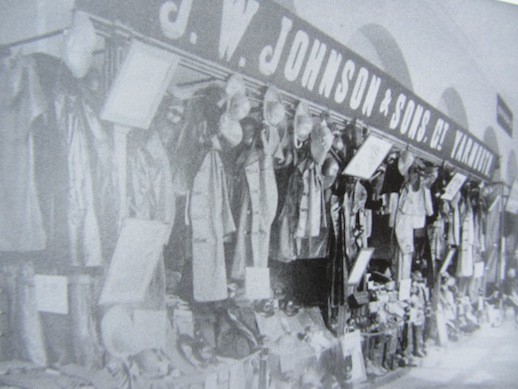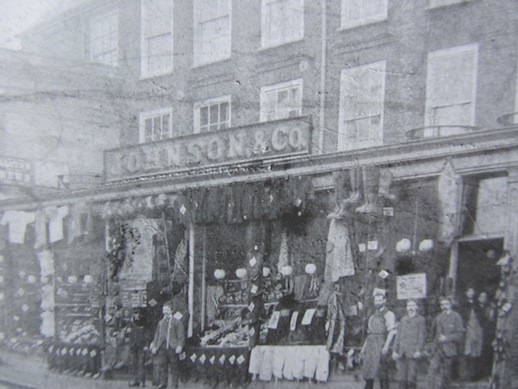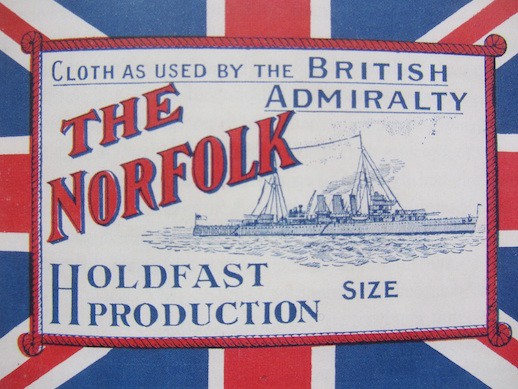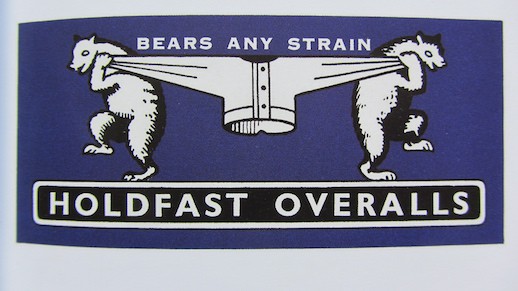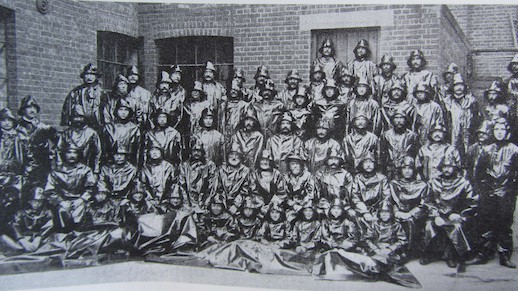 The photo accompanying the 1913 article is captioned ‘A Group of Men all wearing Yarmouth Oilskins manufactured by Messrs. Johnson & Sons Ltd’. Some of the young men pictured would be leaving their jobs the following year to fight for their country in France
The photo accompanying the 1913 article is captioned ‘A Group of Men all wearing Yarmouth Oilskins manufactured by Messrs. Johnson & Sons Ltd’. Some of the young men pictured would be leaving their jobs the following year to fight for their country in France
The History of Johnson & Sons Ltd, Great Yarmouth by Ann Green (Holm Publishing)
Review by John Andrews
‘We are but women mild and meek
We work for Johnson’s all the week
The more we work the more we may
It makes no difference to our pay
On Monday morn we start our toil
Among the navy serge and oil
And on the clock our eyes are fixed
We gently murmur ‘Roll on Six’.’
The chances are that if anyone has ever said to you with the straightest of faces ‘We Always Dress Like This’ then they will be togged up in clobber which bears the label Johnson & Sons: Great Yarmouth. Kitted out in a combination of any of the following: Apron or Black Worsted Knicker Hose, Cardigan or Boiler Suit, Dungaree or Duffell Trouser, Umpire Coat or Grey Flannel Shirt, a Mersey Guernsey and a Yachting Cap, Kersey Drawers under Fearnoughts, a Ready-Made Pilot, The Bomber, The Cruiser, The Norfolk or the Hood made in cloth ‘used by the BRITISH ADMIRALTY’, or jauntily sporting a pair of HOLDFAST Overalls tested on bears, drenched from head to toe in pre-patent oilskin Sou’westers ‘made for seamen & fishermen’ or adorned with Drabbetts and Mitts. These things all bright and beautiful for two centuries the girls at Johnson’s in Yarmouth made them all.
In her book Ann Green tells the story of Johnson’s from its birth at the hands of a retired professional soldier and a tailoress in the early 1800’s right through to the company’s demise at the hands of ‘whizz kids’ in the 1980’s. The lifespan of the firm mirrors that of the rise and fall of Empire as a soldier-cum-shoemaker sets about not painting the countries of the world red but in covering its seas in a thick coat of linen dressed in linseed oil or paraffin wax and then watches from his grave as upon those very seas are shipped cheaper products from elsewhere to sink the mighty firm that once won medals at every trade exhibition it entered. It is a pre-Barbour story of deckies and herring girls, boiler stokers, pattern cutters, missed patents and 15 year old ‘runabouts’. Green takes your hands and steeps them in the oils and waxes of the production line, deafens you with the sound of the steam powered machinery and startles you with the screams of workers with needle finger. Then she quietly sets you down to sleep in the giant scrap pile of offcuts as the girls on the line did with a one-too-many Ronnie Webb when the checker came round. Through numerous interviews with the surviving 20th Century employees you learn that perhaps you should not have thrown away that cardboard branding on the back of those Millets jeans you bought in 1977 as the same girls who looked after Ronnie Webb had written their names and addresses on the back before they stapled it on in the hope of making contact with someone beyond the factory gates in other words someone who did not live within Great Yarmouth. Green introduces you to Harry Halfnight and to Herbert ‘Slasher’ Watts, to Ethel Chubbock, to Myrtle Rix and to Lily Cooke who served on the line for 41 years by which time she could make a complete shirt for Denny’s of London in under 20 minutes. Green’s book is a testament to all of the townsfolk who worked at Johnson’s which for a time was Yarmouth as much as Yarmouth was Johnson’s. Like so many factories in so many towns. Long before its 1970’s directors relocated the factories to Somerset and invested the firm’s money in land deals in America in a Perrinesque charade of management strategy which alongside pressure from cheap imports, the impact of decimalization and declining orders from a shrinking Armed Forces made someone call in Ronnie Webb and ask him to turn out the lights for one last time,’I first closed Admiralty Road. I walked through that factory remembering all them girls and all them machines and the people there – that was heartbreaking. It sent a cold feeling through me.’
Goodbye then to the place which made Drab Dabbetts, Cooks Caps, Aprons, Boiler Suits, Football Knickers, Butchers Coats with Prussian Collars, Ribbed Guernseys, Boot Socks and Heavy Natural Pants, tell the band to strike up no more for staff dinner dances at Gunton Hall, farewell to a philanthropic family firm who found work on the town’s tea stalls for the machinists when orders slackened. Let the bell toll for the girls and boys at Middlegate Street, on Hosiery Row, down Admiralty Road and on Pier Plain. Holdfast! Holdfast! for their collective memory preserved in this blue plaque of a book and reflect for a moment in your imported cheaps upon the words that closed a piece on Johnson’s in Men’s Wear Magazine of July 1975:
‘Old skills, old ways, old values shouldn’t be thrown out too casually, often enough the need for them returns more quickly than imagined’.
